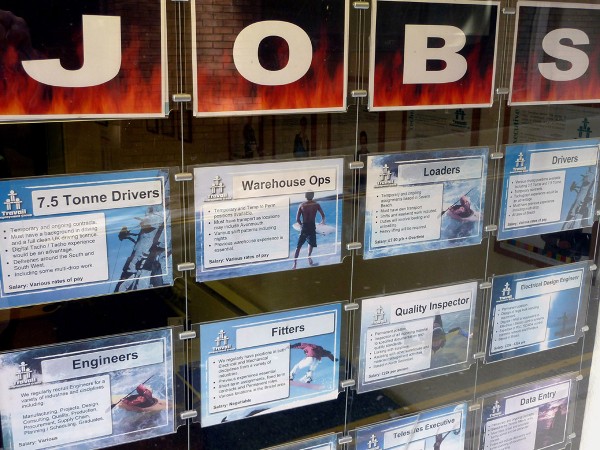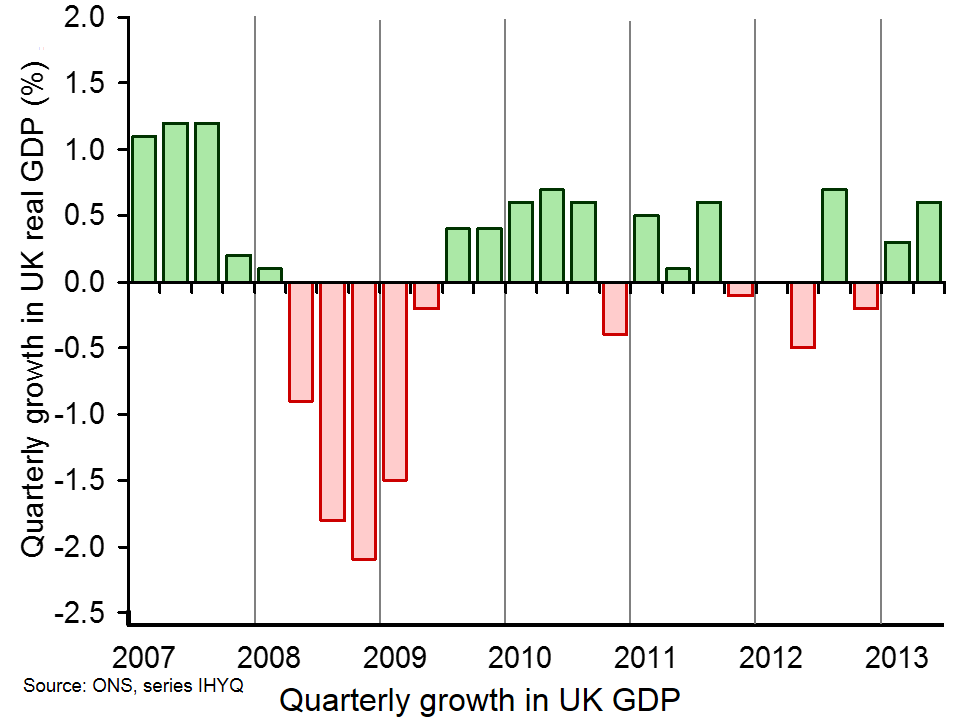 Despite the prolonged stagnation in the UK, unemployment has not soared. In fact, over the past two years the ILO unemployment rate (see here for a definition) has fallen slightly – from 8.6% in October 2011 to around 8.0% today. What is more, the claimant count rate is considerably lower than the ILO rate – at around 4.4%.
Despite the prolonged stagnation in the UK, unemployment has not soared. In fact, over the past two years the ILO unemployment rate (see here for a definition) has fallen slightly – from 8.6% in October 2011 to around 8.0% today. What is more, the claimant count rate is considerably lower than the ILO rate – at around 4.4%.
Part of the reason for the relatively good unemployment figures is the rise in ‘zero-hours contracts’. These allow employers to cut the hours that people work without laying them off. The Office for National Statistics estimates that last year (2012) 250,000 people, or 0.84% of the workforce, were on such contracts.
But just what is meant by ‘zero-hours contracts’? According to the ONS:
People on zero-hours contracts are classified as being in employment regardless of the number of hours they actually worked during the survey reference week. This includes anyone who was not required to work any hours during the reference week whilst remaining on their current contract of employment. The continued existence of the contract of employment is the key determinant of their employment status in these situations.
If people are working less than they would like to, this is classified as underemployment, but such people do not appear in the unemployment statistics. Such contracts thus mask the true extent of surplus labour in the economy.
The Chartered Institute of Personnel and Development (CIPD) puts the figure much higher than the ONS. In the Summer 2013 issue of its Labour Market Outlook, it estimates that one million workers are on zero-hours contracts.
 Many employers use such contracts, including many voluntary-sector and public-sector organisations, including the NHS, local councils and Buckingham Palace. They are also used by many small and medium-sized enterprises and many well-known large companies, such as Sports Direct, Amazon, JD Wetherspoon and Cineworld. It gives them the flexibility to adjust the hours they employ people. It allows them to keep people in employment when demand is low. It also makes them more willing to take on staff when demand rises, as it removes the fear of being over-staffed if demand then falls back.
Many employers use such contracts, including many voluntary-sector and public-sector organisations, including the NHS, local councils and Buckingham Palace. They are also used by many small and medium-sized enterprises and many well-known large companies, such as Sports Direct, Amazon, JD Wetherspoon and Cineworld. It gives them the flexibility to adjust the hours they employ people. It allows them to keep people in employment when demand is low. It also makes them more willing to take on staff when demand rises, as it removes the fear of being over-staffed if demand then falls back.
But many workers dislike such contracts, which give them fewer employment rights and fewer hours than they would like to work. It also makes it difficult to budget when future income is uncertain. It also make credit and mortgages harder to obtain, as people have no guaranteed income. Another complaint is that companies may use the threat of lower hours as a tool to bully staff and get away with poorer working conditions.
In May of this year, the Business Secretary, Vince Cable, announced that he was setting up a review of zero hours contracts.
 Note that zero hours are not the only form of flexible working. Other examples include: ‘self-employed’ workers, contracted separately for each job they do for a company; people paid largely or wholly on commission; on-call working; part-time working, where the hours are specified in advance, but where these are periodically re-negotiated; overtime; people producing a product or service for a company (perhaps at home), where the company varies the amount paid per unit according to market conditions.
Note that zero hours are not the only form of flexible working. Other examples include: ‘self-employed’ workers, contracted separately for each job they do for a company; people paid largely or wholly on commission; on-call working; part-time working, where the hours are specified in advance, but where these are periodically re-negotiated; overtime; people producing a product or service for a company (perhaps at home), where the company varies the amount paid per unit according to market conditions.
The following videos and articles look at the issue in some detail: at the extent of the practice and at its benefits to employers and its costs (and some benefits) to workers. Both The Guardian and the BBC have an extensive range of articles on the topic.
Webcasts
 Do zero hours contracts create real jobs? BBC Newsnight, Allegra Stratton (14/8/12)
Do zero hours contracts create real jobs? BBC Newsnight, Allegra Stratton (14/8/12)
 Record number of ‘Zero Hours Contracts’ ITV News on YouTube, Laura Kuenssberg (2/5/13)
Record number of ‘Zero Hours Contracts’ ITV News on YouTube, Laura Kuenssberg (2/5/13)
 Britons rally against ‘Zero Hour’ contracts Al Jazeera on YouTube (4/8/13)
Britons rally against ‘Zero Hour’ contracts Al Jazeera on YouTube (4/8/13)
 Anger at Amazon working conditions Channel 4 News (1/8/13)
Anger at Amazon working conditions Channel 4 News (1/8/13)
 Government to include Amazon in its zero hours probe Channel 4 News (2/8/13)
Government to include Amazon in its zero hours probe Channel 4 News (2/8/13)
 Councils using zero hours contracts BBC London, Warren Nettleford (31/7/13)
Councils using zero hours contracts BBC London, Warren Nettleford (31/7/13)
Podcasts
 The real economy: Labour market BBC Today Programme, Evan Davis (24/8/11)
The real economy: Labour market BBC Today Programme, Evan Davis (24/8/11)
 Zero hour contracts ‘just the norm’ BBC Today Programme, Rochelle Monte and Peter Cheese (5/8/13)
Zero hour contracts ‘just the norm’ BBC Today Programme, Rochelle Monte and Peter Cheese (5/8/13)
Articles
Zero-hours contracts: One million British workers could be affected Independent, Nigel Morris (5/8/13)
Zero hours contracts “spreading like wildfire”, official stats show Union News, Pete Murray (1/8/13)
Zero-hours contracts: what are they? The Guardian, Phillip Inman (30/7/13)
Buckingham Palace uses zero-hours contracts for summer staff The Guardian, Simon Neville, Matthew Taylor and Phillip Inman (30/7/13)
Nick Clegg: business department will investigate zero-hours contracts The Guardian,
Patrick Wintour, Simon Neville, Matthew Taylor and Phillip Inman (31/7/13)
Zero-hours contracts are not unavoidable The Guardian, Phillip Inman (1/8/13)
ONS admits it underestimated number of zero-hours contracts The Guardian, Simon Neville (1/8/13)
Zero-hours contract workers – the new reserve army of labour? The Guardian, Philip Inman (4/8/13)
Zero-hours contracts cover more than 1m UK workers The Guardian, Simon Goodley and Phillip Inman (5/8/13)
Zero-hours contracts use by councils needs to be moderated The Guardian, Vidhya Alakeson (5/8/13)
If zero-hours contracts are driving this ‘recovery’, it’s a lousy kind of recover The Guardian, Deborah Orr (9/8/13)
ONS increases its estimate of workers on zero hours contracts Financial Times, John Aglionby (1/8/13)
Zero Hours Herald Scotland, Ian Bell and Scott Dickson (4/8/13)
Sports Direct protests planned over zero hours contracts Channel 4 News (3/8/13)
Cable warns of exploitation of zero-hours contracts BBC News (5/8/13)
Q&A: What are zero-hours contracts? BBC News (5/8/13)
Record number of 16-24s on zero hours contracts at work BBC Newsbeat, Jim Reed (15/5/13)
Figures show 18-24s most likely on zero-hours contract BBC Newsbeat, Jim Reed and Amelia Butterly (5/8/13)
Andy Burnham calls for ban on zero hours contracts BBC News (28/4/13)
Zero-hours contracts: What is it like living on one? BBC News, Sean Clare (5/8/13)
Small Talk: Zero-hours contracts? Key for growth Independent, David Prosser (5/8/13)
Zero Hour Contracts Manchester based law firm, Emma Cross (30/7/13)
Data
People and proportion in employment on a zero-hour contract ONS (31/7/13)
Estimating Zero-Hour Contracts from the Labour Force Survey ONS (26/7/13)
One million workers on zero hours contracts, finds CIPD study CIPD, Michelle Stevens (5/8/13)
Labour Market Outlook CIPD
Questions
- Distinguish between open unemployment, disguised unemployment and underemployment?
- Distinguish between functional, numerical and financial flexibility? Which type or types of flexibility do zero-hours contracts give the firm?
- Identify the various benefits to employers of zero-hours contracts?
- What are the costs and benefits to workers of such contracts?
- Identify what forms of flexible contracts are used for staff in your university or educational establishment. Do they benefit (a) staff; (b) students?
- Are zero-hours contracts fair?
- In what ways do zero-hours contracts transfer risks from employers to employees?
- If a company introduces a system of zero-hours contracts, is this in accordance with the marginal productivity theory of profit maximisation from employment?
- From the perspective of the employer, how do the benefits of zero-hours contracts compare with other forms of flexible working?
- Consider the arguments for and against (a) banning and (b) regulating zero-hours contracts.
 A few weeks ago, Elizabeth wrote a blog on the payday loan industry and its referral by the OFT to the Competition Commission (see A payday inquiry). Now the Archbishop of Canterbury, Justin Welby, has joined the debate. He suggests that the problem of sky-high interest rates charged by payday loan companies would be tackled better by increased competition from elsewhere in the industry than by regulation.
A few weeks ago, Elizabeth wrote a blog on the payday loan industry and its referral by the OFT to the Competition Commission (see A payday inquiry). Now the Archbishop of Canterbury, Justin Welby, has joined the debate. He suggests that the problem of sky-high interest rates charged by payday loan companies would be tackled better by increased competition from elsewhere in the industry than by regulation.
In particular, he proposes an expansion of credit unions. These could provide a much cheaper alternative for people in financial difficulties who are seeking short-term loans. He would like church members with relevant skills to volunteer at credit unions and proposes setting up local credit unions operated from church buildings.
* * * * * * * * * *
In this news item we hand over to ‘Kostas Economides’, an imaginary lecturer in Economics at the imaginary ‘University of the South of England’. Kostas’s blog is written by Guy Judge. Guy recently retired from the University of Portsmouth, where he was Deputy Head of Department, and is now a Visiting Fellow.
 In his blog, Kostas frequently reflects on various economic issues, as well as on life at USE. Here he recounts a conversation with his colleagues about Justin Welby’s proposals. They consider various implications of the proposals from an economist’s point of view.
In his blog, Kostas frequently reflects on various economic issues, as well as on life at USE. Here he recounts a conversation with his colleagues about Justin Welby’s proposals. They consider various implications of the proposals from an economist’s point of view.
Kostas’s blog
Pay day loans Guy’s Other Stuff, Guy Judge (30/7/13)
To provide some background to Kostas’s blog, you’ll see below the normal set of links to newspaper articles.
We may well return to Kostas in the near future, as he is planning to look at a number of topical economic issues.
Articles
Why I support Justin Welby’s battle with Wonga The Telegraph, Jacob Rees-Mogg (30/7/13)
 Church plans to compete with payday lender Wonga BBC News, Robert Piggott (25/7/13)
Church plans to compete with payday lender Wonga BBC News, Robert Piggott (25/7/13)
Archbishop of Canterbury wants to ‘compete’ Wonga out of existence The Guardian, Miles Brignall (25/7/13)
Let the payday lenders prosper, but not extort Financial Times (30/7/13)
Coalition will support Archbishop of Canterbury Justin Welby’s plan for credit unions, says Vince Cable Independent, Andrew Grice (28/7/13)
Former Archbishop Rowan Williams backs action against payday loan firms Cambridge News, Jennie Baker (30/7/13)
Why Justin Welby’s vision of kumbayah capitalism is wrong The Telegraph, James Quinn (25/7/13)
Wonga V The Church: Comparing Interest Rates Of Payday Loans And Credit Unions The Huffington Post, Tom Moseley (25/7/13)
Wonga Warned Church Of England Could ‘Compete’ It Out Of Existence The Huffington Post, Tom Moseley (25/7/13)
Credit unions thriving even before Archbishop Welby’s attack on Wonga The Guardian, Rupert Jones (29/7/13)
Questions
- Find out the monthly interest rates being charged by various payday loan companies. Take one loan company as an example and calculate what would happen to your debt over the course of a year if you borrowed £100 and paid nothing back each month. What would be the annualised rate of interest?
- What are the arguments for and against banning payday loan companies?
- What are the arguments for and against imposing an interest rate cap on such companies?
- What are the differences between credit unions and banks?
- Should the interest rates charged by credit unions be uncapped?
- Explain what is meant by ‘moral hazard’ and give some examples. What moral hazard would there be in placing a limit on the number of months over which a debt could go on accumulating?
- How would you decide what a ‘normal’ rate of interest should be? Should this vary with the risk of default and, if so, by how much?
 Japan has suffered from deflation on and off for more than 20 years. A problem with falling prices is that they discourage spending as people wait for prices to fall further. One of the three elements of the Japanese government’s macroeconomic policy (see Japan’s three arrows) has been expansionary monetary policy, including aggressive quantitative easing. A key aim of this is to achieve an inflation target of 2% and, hopefully, propel the economy out of its deflationary trap.
Japan has suffered from deflation on and off for more than 20 years. A problem with falling prices is that they discourage spending as people wait for prices to fall further. One of the three elements of the Japanese government’s macroeconomic policy (see Japan’s three arrows) has been expansionary monetary policy, including aggressive quantitative easing. A key aim of this is to achieve an inflation target of 2% and, hopefully, propel the economy out of its deflationary trap.
The latest news, therefore, from Japan would seem to be good: consumer prices rose 0.4% in June – the first rise for more than a year. But while some analysts see the rise in prices to be partly the result of a recovery in demand (i.e. demand-pull inflation), others claim that the inflation is largely of the cost-push variety as the weaker yen has increased the price of imported fuel and food.
 If Japanese recovery is to be sustained and broadly based, a growth in real wages should be a core component. As it is, real wages are not growing. This could seriously constrain the recovery. For real wages to grow, employers need to be convinced that economic recovery will be sustained and that it would be profitable to take on more labour.
If Japanese recovery is to be sustained and broadly based, a growth in real wages should be a core component. As it is, real wages are not growing. This could seriously constrain the recovery. For real wages to grow, employers need to be convinced that economic recovery will be sustained and that it would be profitable to take on more labour.
The success of the expansionary policy, therefore, depends in large part on its effect on expectations. Do people believe that prices will continue to rise? Do employers believe that the economy will continue to expand? And do people believe that their real wages will rise?
Articles
Japan prices turn higher, but BOJ’s goal remains tall order Reuters, Tetsushi Kajimoto and Leika Kihara (26/7/13)
How Japan Could Go from Deflation to Hyperinflation in a Heartbeat The Wall Street Journal, Michael J. Casey (24/7/13)
Japan Prices Rise Most Since ’08 in Boost for Abe Bloomberg, Toru Fujioka & Andy Sharp (26/7/13)
Japan central bank finds the pessimists come from within Reuters, Leika Kihara (26/7/13)
Japan’s Fiscal Crossroads: Will Abenomics Mean Tougher Changes? The Daily Beast, Daniel Gross (26/7/13)
Japan Economist Makes Rare Call to Tackle Debt The Wall Street Journal, Kosaku Narioka (25/7/13)
Japanese Consumer Prices Rise In Sign Of Some Success In Abe Economic Policy International Business Times, Nat Rudarakanchana (26/7/13)
Data
Bank of Japan Statistics Bank of Japan
Statistics Statistics Bureau of Japan
International sites for data Economics Network
Questions
- Distinguish between cost-push and demand-pull inflation? Do higher prices resulting from a depreciation of the currency always imply that the resulting inflation is of the cost-push variety?
- In the Japanese context, is inflation wholly desirable or are there any undesirable consequences?
- Consider whether a two-year time frame is realistic for the the Bank of Japan to achieve its 2% inflation target.
- What is meant by the output gap? Using sources such as the European Commission’s European Economy, AMECO database and the OECD’s Economic Outlook: Statistical Annex Tables (see sites 6 and 7 in the Economics Network’s links to Economic Data freely available online) trace the Japanese output gap over the past 10 years and comment on your findings.
- What supply-side constraints are likely to limit the rate and extent of recovery in Japan? What is the Japanese government doing about this (see the third arrow of Japan’s three arrows)?
 The Preliminary Estimate of the UK Q2 GDP figures by the Office for National Statistics show that the UK economy grew by 0.6% in the second quarter of 2013: double the growth rate of the first quarter and almost back to the long-run average growth rate prior to 2008.
The Preliminary Estimate of the UK Q2 GDP figures by the Office for National Statistics show that the UK economy grew by 0.6% in the second quarter of 2013: double the growth rate of the first quarter and almost back to the long-run average growth rate prior to 2008.
At first sight, this would seem to be good news – certainly from the government’s point of view. What is more, unlike the previous quarter, growth is spread relatively evenly across the three main sectors: the production (manufacturing, mining, water supply, etc.) and services sectors both grew by 0.6% and the construction sector by 0.9% (this sector fell by 1.8% in the previous quarter). (Click here for a PowerPoint of the chart below.)
 But while growth in the latest quarter may be balanced between the broad sectors, the rise in aggregate demand is not balanced between its components. As an earlier news item (A balancing act) showed, the rise in aggregate demand has been driven largely by a rise in consumption, and a corresponding fall in saving. Exports are rising only slowly and investment is some 25% lower than in the boom years prior to 2008.
But while growth in the latest quarter may be balanced between the broad sectors, the rise in aggregate demand is not balanced between its components. As an earlier news item (A balancing act) showed, the rise in aggregate demand has been driven largely by a rise in consumption, and a corresponding fall in saving. Exports are rising only slowly and investment is some 25% lower than in the boom years prior to 2008.
So will the latest growth be sustainable? Will investment now begin to pick up and what constraints are there on investment? The following articles consider some of the issues.
Articles
Economy firing on all cylinders as growth hits 0.6pc The Telegraph, Philip Aldrick (25/7/13)
The good, the bad or the ugly? How the UK economy stands up. The Telegraph, Philip Aldrick (25/7/13)
George Osborne’s 0.6% growth is good but unspectacular The Guardian, Larry Elliott (25/7/13)
The (not-so) green shoots of recovery The Economist, John Van Reenen (23/7/13)
Economic recovery slow to take root for some in UK Reuters, William Schomberg and Max De Haldevang (25/7/13)
 GDP figures offer hard evidence for political narrative BBC News, Paul Mason (25/7/13)
GDP figures offer hard evidence for political narrative BBC News, Paul Mason (25/7/13)
Ignore the hype: Britain’s ‘recovery’ is a fantasy that hides our weakness The Observer, Will Hutton (21/7/13)
UK economy: Half-speed ahead BBC News, Stephanie Flanders (25/7/13)
BoE guidance can help sustain the UK recovery The Economist, Kevin Daly (22/7/13)
George Osborne’s description of the economy is near-Orwellian The Guardian, Ha-Joon Chang (26/7/13)
Economic growth: more must be done to encourage investment The Guardian, Phillip Inman (1/8/13)
Data
Gross Domestic Product: Preliminary Estimate, Q2 2013 ONS (25/7/13)
Questions
- Compare the macroeconomic situation today with that prior to the financial crisis of 2007/8 and subsequent recession.
- What factors will determine the sustainability of the UK economic recovery?
- What is meant by the ‘accelerator’ and what will determine the size of any accelerator effect from the latest rise in UK GDP?
- What supply-side constraints are likely to limit the rate and extent of recovery?
- Why do economies that are in recession ‘naturally bounce back’ without any government intervention? Have the macroeconomic policies of the UK government helped or hindered this bounce back? Explain.
- What monetary measures by the Bank of England are most appropriate in the current circumstances?
 Did the benefits of the London Olympics outweigh the costs? The government’s UK Trade and Industry (part of the Department of Business, Innovation & Skills) has just published a report, London 2012, Delivering the economic legacy, which itemises the economic benefits of the games one year on. It claims that benefits to date are some £9.9 billion.
Did the benefits of the London Olympics outweigh the costs? The government’s UK Trade and Industry (part of the Department of Business, Innovation & Skills) has just published a report, London 2012, Delivering the economic legacy, which itemises the economic benefits of the games one year on. It claims that benefits to date are some £9.9 billion.
This compares with costs, estimated to be somewhere between £8.9 billion and £9.3 billion, although this figure does not include certain other costs, such as maintenance of the stadium. Nevertheless, according to the figures, even after just a year, it would seem that the Games had ‘made a profit’ – just.
The £9.9 billion of benefits consist of £5.9 billion of additional sales, £2.5 billion of additional inward investment and £1.5 billion of Olympic-related high value opportunities won overseas.  Most of these can be seen as monetary external benefits: in other words, monetary benefits arising from spin-offs from the Games. The ‘internal’ monetary benefits would be largely the revenues from the ticket sales.
Most of these can be seen as monetary external benefits: in other words, monetary benefits arising from spin-offs from the Games. The ‘internal’ monetary benefits would be largely the revenues from the ticket sales.
In a separate report for the Department of Culture, Media & Sport, Report 5: Post-Games Evaluation, it has been estimated that the total net benefits (net gross value added (GVA)) from 2004 to 2020 will be between £28 billion and £41 billion.
But benefits are not confined just to internal and external monetary benefits: there are also other externalities that are non-monetary. The Culture, Media & Sport report identified a number of these non-monetary externalities. The Summary Report itemises them. They include:
• The health and social benefits of more people participating in sport
• Inspiring a generation of children and young people
• A catalyst for improved elite sporting performance in the UK
• Setting new standards for sustainability
• Improved attitudes to disability and new opportunities for disabled people to participate in society
• Greater social cohesion as communities across the UK engaged with the Games
• Increased enthusiasm for volunteering
• Accelerated physical transformation of East London
• Beneficial socio-economic change in East London
• Important lessons learned for the co-ordination and delivery of other large-scale public and public/private projects
But with any cost–benefit analysis there are important caveats in interpreting the figures. First there may be monetary and non-monetary external costs. For example, will all the effects on social attitudes be positive? Might greater competitiveness in sport generate less tolerance towards non sporty people? Might people expect disabled people to do more than they are able (see)? Second, the costs generally precede the benefits. This then raises the question of what is the appropriate discount rate to reduce future benefits to a present value.
 Perhaps the most serious question is that of the quantification of benefits. It is important that only benefits that can be attributed to the Games are counted and not benefits that would have occurred anyway, even if connected to the Games. For example, it is claimed in the UK Trade & Industry report that much of the Olympic park and stadium for the Winter Olympics in Russia was “designed and built by British businesses”. But was this the direct result of the London Olympics, or would this have happened anyway?
Perhaps the most serious question is that of the quantification of benefits. It is important that only benefits that can be attributed to the Games are counted and not benefits that would have occurred anyway, even if connected to the Games. For example, it is claimed in the UK Trade & Industry report that much of the Olympic park and stadium for the Winter Olympics in Russia was “designed and built by British businesses”. But was this the direct result of the London Olympics, or would this have happened anyway?
Another example is that any inward investment by any company that attended the London Olympics is counted in the £2.5 billion of additional inward investment (part of the £9.9 billion). As the London Evening Standard article below states:
In London, it credited the Games with helping seal the deal for the £1.2 billion investment in the Royal Albert Docks by Chinese developer ABP, the £1 billion investment in Croydon by Australian shopping centre developer Westfield with UK firm Hammerson and the £700 million investment in Battersea Nine Elms by Dalian Wander Group.
It is highly likely that some or all of these would have gone ahead anyway.
Then there are the £5.9 billion of additional sales. These are by companies which engaged with the Olympics. But again, many of these sales could have taken place anyway, or may have displaced other sales.
Many cost–benefit analyses (or simply ‘benefit analyses’) concern projects where there are strong vested interests in demonstrating that a project should or should not go ahead or, in this case, have gone ahead. The more powerful the vested interests, the less likely it is that the analysis can be seen as objective.
Webcasts and Podcasts
 Have Olympics and Paralympics really boosted trade? Channel 4 News, Jackie Long (19/7/13)
Have Olympics and Paralympics really boosted trade? Channel 4 News, Jackie Long (19/7/13)
 Economy boosted by Olympics Sky Sports News, Amy Lewis (19/7/13)
Economy boosted by Olympics Sky Sports News, Amy Lewis (19/7/13)
 Olympic investment boost to last decade – Cable BBC News (19/7/13)
Olympic investment boost to last decade – Cable BBC News (19/7/13)
 Did the UK gain from the Olympics? BBC Today Programme (19/7/13)
Did the UK gain from the Olympics? BBC Today Programme (19/7/13)
Articles
Government announces almost £10bn economic boost from London 2012 Specification Online (19/7/13)
Olympic Legacy Boosted Economy By £10bn, Government Insists The Huffington Post (19/7/13)
Olympics are delivering economic gold but volunteering legacy is at risk The Telegraph, Tim Ross (19/7/13)
Vince Cable: Case for HS2 still being made The Telegraph, Christopher Hope and Tim Ross (19/7/13)
Olympic legacy ‘gave London a £4bn windfall’ London Evening Standard, Nicholas Cecil and Matthew Beard (19/7/13)
London 2012 Olympics ‘have boosted UK economy by £9.9bn’ BBC News (19/7/13)
The great Olympic stimulus BBC News, Stephanie Flanders (19/7/13)
London Olympics still costing the taxpayer one year on Sky Sports (19/7/13)
Mayor missed long-term London Olympic jobs targets, says report BBC News, Tim Donovan (19/7/13)
Olympics legacy: Have the London 2012 Games helped Team GB develop a winning habit? Independent, Robin Scott-Elliot (19/7/13)
London 2012 added up to more than pounds and pence The Guardian, Zoe Williams (19/7/13)
Government Reports
London 2012 – Delivering the economic legacy UK Trade & Investment (19/7/13)
London 2012: Delivering the economic legacy UK Trade & Investment (19/7/13)
Report 5: Post-Games Evaluation: Summary Report Department for Culture, Media & Sport (July 2013)
Report 5: Post-Games Evaluation: Economy Evidence Base Department for Culture, Media & Sport (July 2013)
Questions
- Distinguish between gross and net benefits; monetary and non-monetary externalities; direct costs (or benefits) and external costs (or benefits).
- How should the discount rate be chosen for a cost–benefit analysis?
- Give some examples of monetary and non-monetary external costs of the Games.
- What are the arguments for and against including non-monetary externalities in a cost–benefit analysis?
- Why might the £9.9 billion figure for the monetary benefits of the Games up to the present time be questioned?
 Despite the prolonged stagnation in the UK, unemployment has not soared. In fact, over the past two years the ILO unemployment rate (see here for a definition) has fallen slightly – from 8.6% in October 2011 to around 8.0% today. What is more, the claimant count rate is considerably lower than the ILO rate – at around 4.4%.
Despite the prolonged stagnation in the UK, unemployment has not soared. In fact, over the past two years the ILO unemployment rate (see here for a definition) has fallen slightly – from 8.6% in October 2011 to around 8.0% today. What is more, the claimant count rate is considerably lower than the ILO rate – at around 4.4%. Many employers use such contracts, including many voluntary-sector and public-sector organisations, including the NHS, local councils and Buckingham Palace. They are also used by many small and medium-sized enterprises and many well-known large companies, such as Sports Direct, Amazon, JD Wetherspoon and Cineworld. It gives them the flexibility to adjust the hours they employ people. It allows them to keep people in employment when demand is low. It also makes them more willing to take on staff when demand rises, as it removes the fear of being over-staffed if demand then falls back.
Many employers use such contracts, including many voluntary-sector and public-sector organisations, including the NHS, local councils and Buckingham Palace. They are also used by many small and medium-sized enterprises and many well-known large companies, such as Sports Direct, Amazon, JD Wetherspoon and Cineworld. It gives them the flexibility to adjust the hours they employ people. It allows them to keep people in employment when demand is low. It also makes them more willing to take on staff when demand rises, as it removes the fear of being over-staffed if demand then falls back. Note that zero hours are not the only form of flexible working. Other examples include: ‘self-employed’ workers, contracted separately for each job they do for a company; people paid largely or wholly on commission; on-call working; part-time working, where the hours are specified in advance, but where these are periodically re-negotiated; overtime; people producing a product or service for a company (perhaps at home), where the company varies the amount paid per unit according to market conditions.
Note that zero hours are not the only form of flexible working. Other examples include: ‘self-employed’ workers, contracted separately for each job they do for a company; people paid largely or wholly on commission; on-call working; part-time working, where the hours are specified in advance, but where these are periodically re-negotiated; overtime; people producing a product or service for a company (perhaps at home), where the company varies the amount paid per unit according to market conditions. Do zero hours contracts create real jobs? BBC Newsnight, Allegra Stratton (14/8/12)
Do zero hours contracts create real jobs? BBC Newsnight, Allegra Stratton (14/8/12) Record number of ‘Zero Hours Contracts’ ITV News on YouTube, Laura Kuenssberg (2/5/13)
Record number of ‘Zero Hours Contracts’ ITV News on YouTube, Laura Kuenssberg (2/5/13) Britons rally against ‘Zero Hour’ contracts Al Jazeera on YouTube (4/8/13)
Britons rally against ‘Zero Hour’ contracts Al Jazeera on YouTube (4/8/13) Anger at Amazon working conditions Channel 4 News (1/8/13)
Anger at Amazon working conditions Channel 4 News (1/8/13) Government to include Amazon in its zero hours probe Channel 4 News (2/8/13)
Government to include Amazon in its zero hours probe Channel 4 News (2/8/13) Councils using zero hours contracts BBC London, Warren Nettleford (31/7/13)
Councils using zero hours contracts BBC London, Warren Nettleford (31/7/13) The real economy: Labour market BBC Today Programme, Evan Davis (24/8/11)
The real economy: Labour market BBC Today Programme, Evan Davis (24/8/11) Zero hour contracts ‘just the norm’ BBC Today Programme, Rochelle Monte and Peter Cheese (5/8/13)
Zero hour contracts ‘just the norm’ BBC Today Programme, Rochelle Monte and Peter Cheese (5/8/13)







